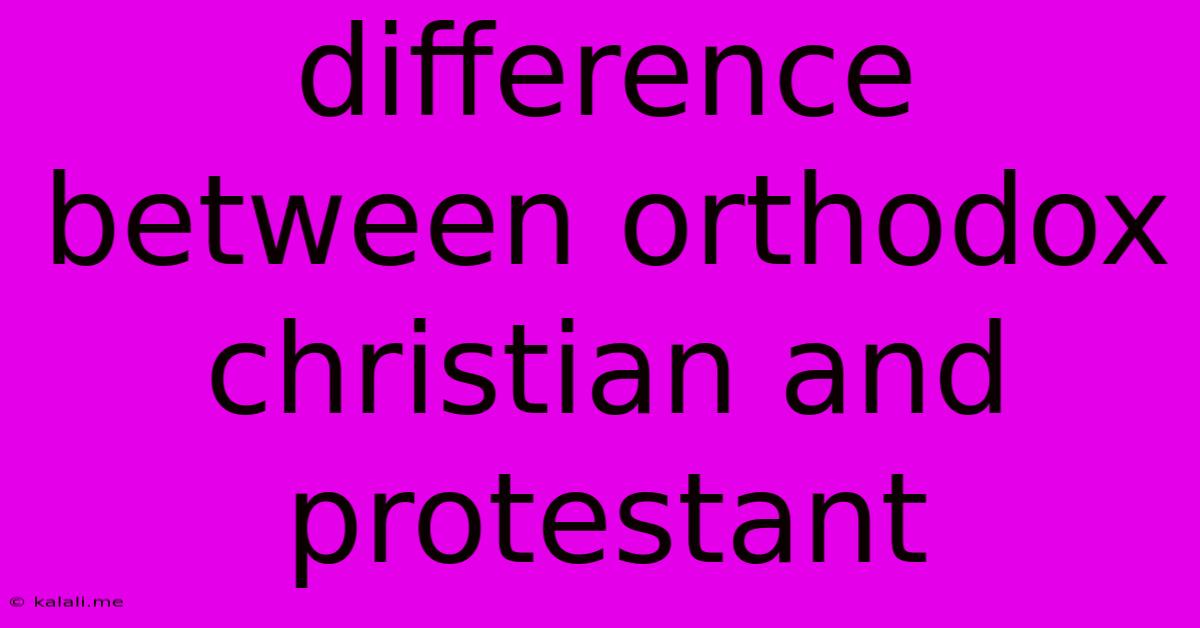Difference Between Orthodox Christian And Protestant
Kalali
May 20, 2025 · 3 min read

Table of Contents
The Great Divide: Understanding the Differences Between Orthodox and Protestant Christianity
The Christian faith, while united in its core belief in Jesus Christ, encompasses a vast tapestry of denominations and traditions. Among the most significant branches are the Eastern Orthodox Church and the Protestant churches. While both share a common ancestor in early Christianity, centuries of theological debate and historical events have led to significant differences in doctrine, practice, and ecclesiology. This article explores the key distinctions between these two major branches of Christianity. Understanding these differences is crucial for fostering interfaith dialogue and appreciating the rich diversity within the Christian world.
Key Differences in Theology and Practice
The chasm between Orthodox and Protestant Christianity stems from several key theological disagreements, most prominently arising during the Reformation of the 16th century. These differences manifest in various aspects of worship, governance, and understanding of scripture.
1. Authority and Tradition:
- Orthodox Christianity: Places significant emphasis on Sacred Tradition, alongside the Bible. This Tradition, encompassing the teachings of the early Church Fathers, liturgical practices, and canonical decrees, is considered an essential source of theological authority, guiding interpretation of scripture. They believe this unbroken tradition ensures faithful transmission of apostolic teachings.
- Protestantism: Generally emphasizes Sola Scriptura ("Scripture alone") as the ultimate source of religious authority. While many Protestant denominations acknowledge tradition's importance, they prioritize the Bible's literal or interpretive understanding above other sources. This emphasis on biblical authority often leads to varied interpretations across different Protestant denominations.
2. Sacraments:
- Orthodox Christianity: Recognizes seven sacraments: Baptism, Chrismation (Confirmation), Eucharist (Communion), Confession, Marriage, Holy Orders, and Anointing of the Sick. These sacraments are understood as outward signs of inward grace, divinely instituted and essential for salvation.
- Protestantism: Varies significantly depending on the denomination. Most Protestant churches recognize two sacraments: Baptism and Communion (Eucharist). The understanding of these sacraments also differs; some view them as symbolic acts, while others maintain their sacramental nature.
3. Ecclesiology (Church Governance):
- Orthodox Christianity: Maintains a strong emphasis on the historical continuity of the Church tracing its origins back to the apostles. It emphasizes a hierarchical structure with bishops, priests, and deacons, emphasizing the importance of apostolic succession – the unbroken line of ordained bishops from the apostles. Orthodoxy views the Church as one, holy, catholic, and apostolic.
- Protestantism: Embraces a wider range of ecclesiological structures, from congregational governance to presbyterian systems. While some Protestant denominations acknowledge the importance of historical continuity, the Reformation's emphasis on individual conscience and the rejection of papal authority led to a diverse landscape of church structures.
4. The Nature of Christ:
Both traditions affirm the divinity and humanity of Jesus Christ, but nuanced differences exist regarding his nature. The Orthodox Church carefully articulates the hypostatic union, emphasizing the full and unconfused union of the divine and human natures in Christ. Some Protestant interpretations, while affirming the same central truth, may differ in their emphasis and articulation.
5. Salvation:
Both traditions emphasize salvation through faith in Jesus Christ, but their articulation of this process differs. Orthodoxy highlights the importance of participation in the sacraments and the ongoing process of theosis (deification) through God's grace. Protestantism, largely influenced by Martin Luther's concept of sola fide ("faith alone"), stresses salvation by grace through faith alone, emphasizing God's initiative and humanity's inability to earn salvation.
Conclusion: A Rich Tapestry of Faith
The differences between Orthodox and Protestant Christianity are substantial, spanning theological interpretations, sacramental practices, and church governance. However, it’s crucial to avoid oversimplification. Within both traditions, significant internal diversity exists. Understanding these distinctions requires careful study and a willingness to engage with the rich historical and theological contexts that shaped these distinct expressions of the Christian faith. The ultimate goal should be respectful dialogue and a recognition of the shared faith in Jesus Christ that underpins both traditions.
Latest Posts
Latest Posts
-
Can You Drink Tap Water In Athens
May 20, 2025
-
How To Attach Sleeping Bag To Backpack
May 20, 2025
-
Do References Count In Word Count
May 20, 2025
-
Can I Put Water In My Coolant Tank
May 20, 2025
-
Can Stainless Steel Go Into Oven
May 20, 2025
Related Post
Thank you for visiting our website which covers about Difference Between Orthodox Christian And Protestant . We hope the information provided has been useful to you. Feel free to contact us if you have any questions or need further assistance. See you next time and don't miss to bookmark.